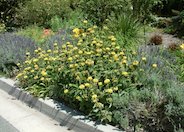
Common name:Jerusalem Sage
Botanical name:Phlomis fruticosa
This hardy perennial is a useful, old-time garden plant with coarse, woolly gray green, wrinkled leaves and yellow, 1" flowers in ball-shaped whorls. It handles drought and poor soils but needs full sun.
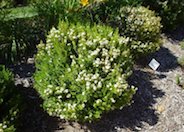
Common name:Compact Myrtle
Botanical name:Myrtus communis 'Compacta'
This evergreen shrub is 6' high and 5' wide with aromatic leaves. It blooms with white, sweet-scented flowers followed by bluish black berries. It can be grown in sun or partial shade; well drained soil is essential. 'Compacta' has smaller leaves and is often used for edges and low formal hedges.
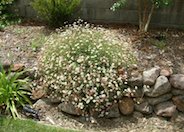
Common name:Santa Barbara Daisy, Mexican Daisy
Botanical name:Erigeron karvinskianus
This low mounding perennial, with fine leaves and white to pinkish, daisy-like flowers, is an excellent asset to rock gardens.
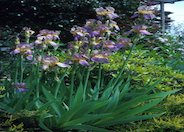
Common name:Bearded Iris
Botanical name:Iris Bearded Hybrids
This perennial will grow 1'-3' tall and has medium sized, blue green leaves with flowers of different colors that bloom in spring. It needs well draining soil and full sun. Many are fragrant and rebloom several times a year. Plant rhizomes in Sept or Oct. They need water once a week during the hot spells. Top dress with compost and gypsum in January and August.
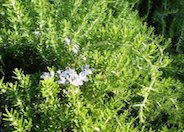
Common name:Rosemary
Botanical name:Rosmarinus officinalis
Rosemary is hardy in full sun areas where winter temperatures do not drop below 10 degrees F. They can be grown in a clay pot with well-drained, porous soil in bright indoor light, and will also flourish on the backporch in spring, summer and fall. Its beautiful, slowly trailing stems and shiny slender leaves are perfect for showing off the small, light blue flowers that blossom in the summer. -Holland WIldflower Farm
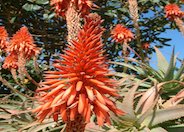
Common name:Tree Aloe
Botanical name:Aloe arborescens
This succulent is large, full of branches and produces deep red orange blooms in fall and winter. The flowers produce a nectar that is attractive to many different birds; this plant is grown all over the world. This succulent can reach 8' tall and 5' wide. Leaves are narrow, recurved and tooth margined and can be green or yellowish or blue green, depending on how much sun it receives. It tolerates sun or shade.
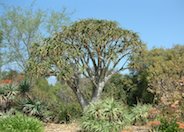
Common name:Baines Tree Aloe
Botanical name:Aloe barberae
This slow-growing tree has a heavy trunk with forking branches. It produces 2'-3' leaves in rosettes and rose/pink flowers.
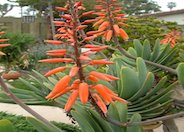
Common name:Fan Aloe
Botanical name:Aloe plicatilis
This wide succulent shrub grows 3'-6' tall and wide, with fan-like clusters of the bluish-gray round tipped leaves. From each fan emerges an open terminal cluster of tubular, orange red flowers in late winter to early spring. Plant in full sun if on the coast or in shade if inland. It is hardy to about 23 degrees F. It needs winter and spring irrigation if grown where does does not receive adequate water from rainfall.
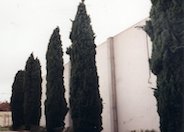
Common name:Italian Cypress
Botanical name:Cupressus sempervirens 'Stricta'
Italian Cypress is often associated with Italian and Spanish architecture, providing columns in the landscape. They often reach 60' tall. 'Stricta' is compact, columnar and produces long, straight branches with deep green foliage.
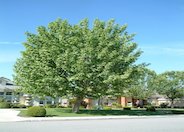
Common name:California Sycamore
Botanical name:Platanus racemosa
The California Sycamore is a fast growing deciduous tree that reaches up to 40'-50' high. It tolerates heat, smog, as well as moist conditions; it is native to riparian areas. It can be drought tolerant once it's established if there is a high water table. It has interesting mottled bark when the tree is bare in winter. Leaves in fall are gold, red and orange, creating litter. It is beautiful all year round.
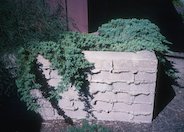
Common name:Dwarf Japanese Garden Juniper
Botanical name:Juniperus procumbens 'Nana'
The very dense growth of this plant is highlighted by foliage of a bluish green color. Its growth habit is very low, spreading, and mound-like, resembling a natural bonsai. This variety is one of the best Junipers for small garden spaces. Junipers are highly combustible plants.
| Designer: Stephanie Blanc | California Greek Garden 12 |
Photographer: GardenSoft |
Soils and Compost:
Incorporate compost 6" into your soil to retain water, reduce compaction, feed earthworms, and provide valuable nutrients to your plants.
Integrated Pest Management:
Drip and other smart irrigation delivers water directly to roots, allowing no excess water for weeds.
